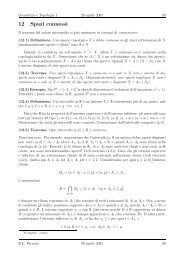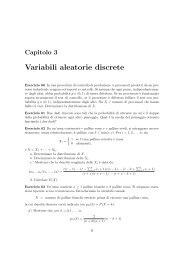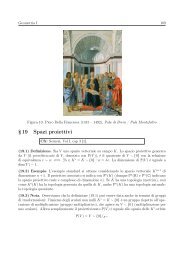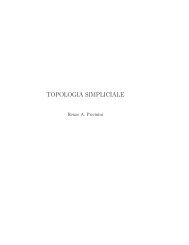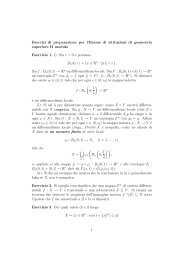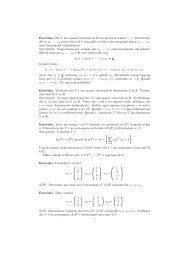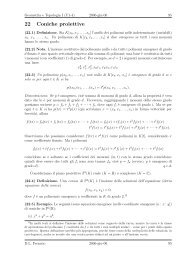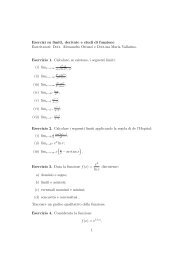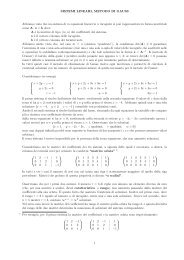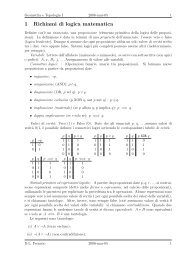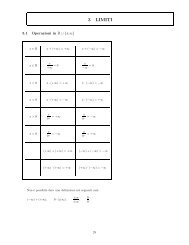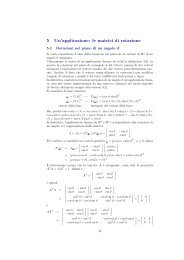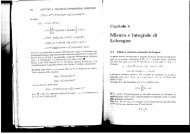Momenta of a vortex tangle by structural complexity analysis
Momenta of a vortex tangle by structural complexity analysis
Momenta of a vortex tangle by structural complexity analysis
Create successful ePaper yourself
Turn your PDF publications into a flip-book with our unique Google optimized e-Paper software.
Author's personal copy2226 R.L. Ricca / Physica D 237 (2008) 2223–2227Theorem 4.2 (Signed Area Interpretation). Let T be a <strong>vortex</strong><strong>tangle</strong> evolving under LIA. Then, the linear momentumP = P(T ) has componentsP xy =Z∑γ j I j A xy (R j ), P yz = · · · , P zx = · · · , (9)j=1and the angular momentum M = M(T ) has componentsM xy = d zZ∑γ j I j A xy (R j ), M yz = · · · , M zx = · · · ,(10)j=1where A xy (R j ), . . . , etc. denotes standard area <strong>of</strong> R j .Pro<strong>of</strong> <strong>of</strong> the above theorem is based on direct applications <strong>of</strong>(4) and (5), <strong>by</strong> using the signed area Rule 3.2.5. Dynamical aspects based on signed area informationSigned area contributions provide useful information, thatcan be applied, predictively, to estimate and, postdictively,to understand some dynamical properties <strong>of</strong> the system.Remember that: (i) areas with index 0 do not contributeto the momentum; (ii) areas with high index (in absolutevalue) weight more and, proportionally, contribute more tothe dynamical impulse <strong>of</strong> the system; (iii) areas <strong>of</strong> oppositesign determine contributions in opposite directions. Additionalinformation on dynamical aspects may also come from indexgradient <strong>analysis</strong>. Take the case <strong>of</strong> Fig. 2(b): here the alignment<strong>of</strong> regions, where the index gradually changes from −1 to +2,indicates the presence <strong>of</strong> a principal axis <strong>of</strong> revolution. Theexact location <strong>of</strong> this axis, placed orthogonally to the alignment<strong>of</strong> such regions, is determined <strong>by</strong> an accurate estimate <strong>of</strong> theweighted areas and, in any case, it can be determined <strong>by</strong> signedarea information.Let us consider two other examples, assuming, forsimplicity, equal circulations and maximal projected areas. InFig. 3(a) we have the projection <strong>of</strong> a single coiled filament, thatin space is wound up 5 times around a circular axis (not shown).Contribution from the 5 negative areas exceeds that from thepositive area, hence the resultant momentum is oriented inthe negative direction. If such a <strong>vortex</strong> configuration existed,it would propagate backwardly in space. Such an unusualbehaviour may not be so unrealistic, as recent analyticalsolutions [14,15] and numerical tests [16] seem to suggest.Another interesting case is illustrated <strong>by</strong> the followingexample. Consider the head-on collision <strong>of</strong> two anti-parallel<strong>vortex</strong> rings, propagating co-axially one against the other.The linear momentum <strong>of</strong> the two-ring system (as a whole) isobviously zero, and in ideal conditions this value is conserveduntil collisional time. In the case <strong>of</strong> real dynamics at sufficientlyhigh Reynolds number, slight perturbations <strong>of</strong> the circularaxes are likely to develop and, upon collision, we can expectthat these will trigger sinusoidal disturbances along the twocolliding ring axes. Here, <strong>analysis</strong> <strong>of</strong> the projected diagrammay be rather illuminating. Without loss <strong>of</strong> generality and forthe sake <strong>of</strong> simplicity, let us drastically simplify the situationand consider the perturbed circular axes as the elliptical curvesFig. 3. (a) Projected diagram <strong>of</strong> a coiled <strong>vortex</strong> filament: contribution fromnegative areas (light grey) exceeds that from positive area (dark grey); hence,the resultant linear momentum <strong>of</strong> the <strong>vortex</strong> is negative. (b) Graph <strong>of</strong> theprojection <strong>of</strong> two anti-parallel, elliptical <strong>vortex</strong> rings: opposite contributionsfrom regions <strong>of</strong> index <strong>of</strong> alternating sign (light grey) cancel out; hence, theresultant linear momentum <strong>of</strong> the two-ring system is zero.sketched in Fig. 3(b) (realistic perturbations would obviouslygenerate a far more complex diagram). The central regionhas index 0 and is surrounded <strong>by</strong> four regions (light grey) <strong>of</strong>alternating sign. Consistently with what we expect from theannihilation <strong>of</strong> the rings velocity, this gives zero contributionto the resultant linear momentum <strong>of</strong> the two-ring system.When the two rings collide, the alternating sign <strong>of</strong> the foursurrounding regions is an indicator <strong>of</strong> an imminent <strong>structural</strong>instability, that produces the shoot-<strong>of</strong>f <strong>of</strong> a pair <strong>of</strong> small<strong>vortex</strong> rings on either side <strong>of</strong> the collisional plane. In arealistic scenario, the precise number <strong>of</strong> surrounding regionswill depend on geometric details <strong>of</strong> the perturbation, but inany case the production <strong>of</strong> an equal number <strong>of</strong> secondarysmall rings on either side <strong>of</strong> the collisional plane must beexpected. These considerations seem confirmed <strong>by</strong> directinspection <strong>of</strong> experimental results (see, for instance, [17]). Inreal experiments a diadem <strong>of</strong> a large number <strong>of</strong> secondarysmall <strong>vortex</strong> rings is clearly visible. This diadem grows fromthe instability <strong>of</strong> a fluid membrane that is produced in thecollisional plane, upon collision <strong>of</strong> the primary large <strong>vortex</strong>rings. These secondary rings appear to be alternately distributedon either side <strong>of</strong> the collisional plane, surviving just for a shorttime before final dissipation.6. Concluding remarksThe geometric method based on the signed area interpretationsummarized <strong>by</strong> Theorem 4.2 provides a new and potentiallyuseful tool for fluid dynamics research. The method exploitsinformation from <strong>structural</strong> <strong>complexity</strong> <strong>analysis</strong> <strong>of</strong> a <strong>tangle</strong><strong>of</strong> <strong>vortex</strong> filaments to estimate linear and angular momenta<strong>of</strong> the system. This is done <strong>by</strong> computing the signed areas <strong>of</strong>the projected graph diagrams associated with the <strong>vortex</strong> <strong>tangle</strong>,



